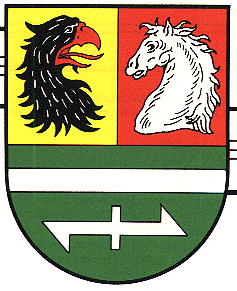Langendamm: Difference between revisions
Knorrepoes (talk | contribs) No edit summary |
Knorrepoes (talk | contribs) m (Text replace - "[[Literature" to "{{media}} [[Literature") |
||
| Line 21: | Line 21: | ||
The eagle's head is taken from the arms of Prussia, as many of the inhabitants of the village originally came from Prussia. The colours are the German national colours. The horse is derived from the arms of the State of Niedersachsen. The lower half shows a silver bar, which is canting (the name means long-dam), but it also symbolises the historical toll gate in the village, between the county of Wölpe and the Duchy of Wolfenbüttel. The other symbol, a so-called wolf's hook, is taken from the arms of the Dukes of Wolfenbüttel, who used it on border stones. | The eagle's head is taken from the arms of Prussia, as many of the inhabitants of the village originally came from Prussia. The colours are the German national colours. The horse is derived from the arms of the State of Niedersachsen. The lower half shows a silver bar, which is canting (the name means long-dam), but it also symbolises the historical toll gate in the village, between the county of Wölpe and the Duchy of Wolfenbüttel. The other symbol, a so-called wolf's hook, is taken from the arms of the Dukes of Wolfenbüttel, who used it on border stones. | ||
{{media}} | |||
[[Literature]] : Ziegler, 1986 | [[Literature]] : Ziegler, 1986 | ||
Revision as of 00:29, 9 July 2014
| Heraldry of the World Civic heraldry of Germany - Deutsche Wappen (Gemeindewappen/Kreiswappen) |
LANGENDAMM
State : Niedersachsen
District (Kreis) : Nienburg
Incorporated into : 1974 Nienburg (Weser)
Official blazon
Origin/meaning
The arms were granted on September 25, 1963.
The eagle's head is taken from the arms of Prussia, as many of the inhabitants of the village originally came from Prussia. The colours are the German national colours. The horse is derived from the arms of the State of Niedersachsen. The lower half shows a silver bar, which is canting (the name means long-dam), but it also symbolises the historical toll gate in the village, between the county of Wölpe and the Duchy of Wolfenbüttel. The other symbol, a so-called wolf's hook, is taken from the arms of the Dukes of Wolfenbüttel, who used it on border stones.
Contact and Support
Partners:
Your logo here ?
Contact us
© since 1995, Heraldry of the World, Ralf Hartemink 
Index of the site
Literature : Ziegler, 1986











